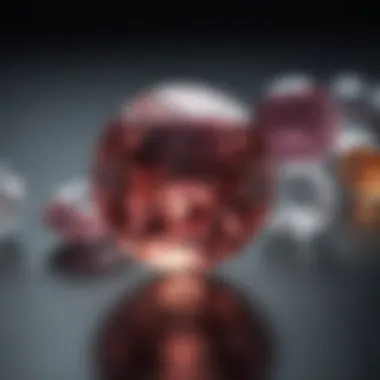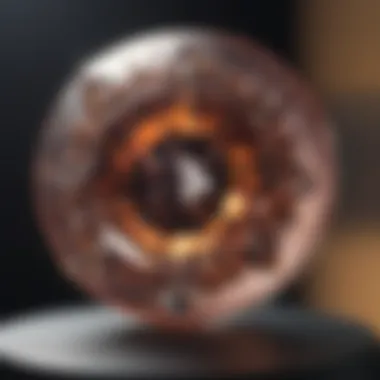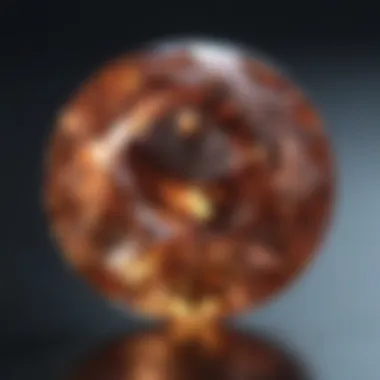Exploring the Fine Differences: Cubic Zirconia vs. Diamond Unveiled


Overview of Gemstones and Minerals
Gemstones and minerals have fascinated humans for centuries, playing a significant role in various facets of society and cultural practices around the world. From adornments in ancient civilizations to symbols of status and luxurious aesthetics in modern times, the history of gemstones and minerals is rich and multifaceted. These exquisite creations of nature carry tales of tradition, spirituality, and beauty that have transcended generations.
Exploring the formation process of gemstones unveils a fascinating journey of how these precious stones are born deep within the Earth's crust. Under intense pressure and temperature conditions, minerals crystallize over millions of years, giving rise to a diverse range of gemstones. The formation process accounts for the unique properties that define each gemstone, such as color, hardness, and luster. These distinguishing characteristics make gemstones not only visually captivating but also scientifically intriguing.
Delving into the classification of gemstones, we encounter the distinction between precious and semi-precious varieties. While diamonds, rubies, sapphires, and emeralds reign as the coveted precious gemstones, semi-precious stones like amethyst, aquamarine, and topaz offer a spectrum of colors and affordability. Additionally, the world of gemstones houses a treasure trove of exotic and rare varieties, each possessing its allure and rarity that captivates gemstone enthusiasts worldwide.
Identifying and Evaluating Gemstones
As a gemstone enthusiast, being able to accurately identify and evaluate gemstones is paramount in understanding their value and quality. Various factors impact the worth of a gemstone, including its color intensity, clarity, cut precision, and carat weight. Utilizing specialized techniques such as magnification, refractometers, and spectrometers aids in gemstone identification, enabling experts to distinguish between cubic zirconia and diamond with precision.
The evaluation of gemstone quality involves assessing aspects like brilliance, fire, and scintillation. These optical properties contribute to the gem's visual appeal and overall value, making a thorough evaluation essential in determining its market worth. By understanding the intricate details of gemstone quality assessment, collectors and jewelry designers can discern between superior and inferior gemstones, ensuring the creation of exquisite and valuable jewelry pieces.
Caring for Gemstones
Proper care and maintenance are vital to preserving the longevity and beauty of gemstones in your collection. Cleaning gemstones regularly with mild soap and a soft brush helps remove dirt and oils that can affect their brilliance. Storing gemstones in separate compartments or soft pouches prevents scratches and damage, maintaining their pristine condition for years to come.
Avoiding common mistakes in gemstone care, such as exposure to harsh chemicals or sudden temperature changes, safeguards the integrity of the gemstones. Following specific preservation tips based on gem type further enhances their durability and aesthetic appeal. By incorporating best practices in gemstone care, you can enjoy the enchanting beauty of your gemstone collection for generations to come.
Introduction
In today's gemstone arena, the ability to distinguish between cubic zirconia and diamond stands as a pivotal skill for enthusiasts, collectors, and jewelry designers. This proficiency unlocks a world of possibilities, enabling individuals to make informed decisions when acquiring or designing jewelry pieces. Understanding the nuances that set these two gemstones apart can elevate one's appreciation of gemological intricacies. Through this comprehensive guide, readers will embark on a journey delving deep into the core disparities between cubic zirconia and diamond, cultivating a discerning eye for gemstones.
The significance of this introduction lies in laying the groundwork for a thorough exploration of cubic zirconia and diamond, shedding light on their distinct characteristics, compositions, and applications. By initiating the discussion with a robust overview, readers are primed to absorb the forthcoming detailed analyses on the visual, physical, and chemical aspects that define these gemstones. This section serves as the gateway to a treasure trove of knowledge, equipping individuals with the requisite understanding to navigate the intricate world of gemology with confidence and clarity.
Understanding Cubic Zirconia
Understanding Cubic Zirconia is paramount in the gemstone world. It serves as the foundation for distinguishing between cubic zirconia and diamond. To comprehend the nuances of these gemstones, one must delve into the composition and properties of cubic zirconia, shedding light on its unique characteristics and distinguishing factors. This section aims to demystify the complexities surrounding cubic zirconia, offering gemstone enthusiasts, collectors, and jewelry designers a comprehensive understanding of this gem.


Composition and Properties
Chemical Makeup of Kubic Zirconia
Delving into the Chemical Makeup of Cubic Zirconia unveils its fundamental structure and defining components. This composition plays a pivotal role in differentiating cubic zirconia from diamond. The key characteristic of the Chemical Makeup lies in its crystalline structure, mimicking the brilliance of a genuine diamond. Understanding this aspect enables enthusiasts to discern the subtle differences between the two gems. Despite its synthetic nature, the Chemical Makeup of Cubic Zirconia offers a cost-effective and visually appealing alternative to natural diamonds. Its unique feature of high optical dispersion enhances its sparkle, making it a popular choice for jewelry designers seeking brilliance without the exorbitant cost. While its affordability is a significant advantage, some may view the lack of rarity as a downside, yet it remains a prominent choice in the jewelry industry.
Physical Characteristics
Exploring the Physical Characteristics of Cubic Zirconia unveils its tangible attributes and aesthetic qualities. The key characteristic lies in its hardness and durability, with a rating close to that of a diamond on the Mohs scale. This feature ensures longevity and resilience in jewelry pieces, making it a practical choice for everyday wear. The distinct feature of Cubic Zirconia's optical clarity contributes to its diamond-like appearance, captivating admirers with its lustrous allure. Its affordability and versatility in color options make it a sought-after gemstone for various design preferences. While its physical resilience is advantageous, its synthetic origin may pose a disadvantage to purists seeking natural gemstones. Despite this, the Physical Characteristics of Cubic Zirconia remain a top contender in the gemstone market.
History and Uses
Origin of Cubic Zirconia
The Origin of Cubic Zirconia traces back to its discovery in the late 20th century, marking a significant advancement in gemstone synthesis. This historical aspect offers insights into the evolution of gemstone manufacturing and the innovation behind creating synthetic diamonds. The key characteristic of Cubic Zirconia's origin lies in its laboratory production, revolutionizing the gem industry with its accessible and ethically sourced alternative to mined diamonds. Its unique feature of consistent quality and abundance caters to diverse consumer demands, establishing Cubic Zirconia as a staple in the jewelry market. While its historical progression showcases technological achievements, some may perceive its man-made origin as a drawback compared to natural gemstones. Nonetheless, the Origin of Cubic Zirconia remains a testament to human ingenuity and technological prowess.
Practical Applications
Exploring the Practical Applications of Cubic Zirconia unveils its versatile uses across various industries. The key characteristic lies in its adaptability as a diamond simulant, offering an affordable and visually appealing option for jewelry makers. The unique feature of Cubic Zirconia's optical properties allows it to mimic the brilliance of diamonds, making it a popular choice for creating intricate and glamorous jewelry pieces. Its durability and affordability make it a practical alternative for everyday wear, catering to a wide range of consumers seeking luxury at a fraction of the cost. While its practicality and accessibility in jewelry design are advantageous, some may critique its synthetic nature for lacking the mystique of natural gemstones. Despite this, the Practical Applications of Cubic Zirconia continue to drive innovation and creativity in the jewelry industry.
Exploring Diamond
In the realm of gemstones, the exploration of diamonds holds paramount significance, delving into the intricate details of their formation, structure, and cultural symbolism. Diamonds, revered for their unparalleled brilliance and durability, have long captured the fascination of gem enthusiasts and jewelry connoisseurs worldwide. By unraveling the mysteries of diamond formation and crystal structure, one can truly appreciate the extraordinary beauty and resilience that these precious stones possess.
Formation and Structure
Diamond Formation Process
The intricate process of diamond formation is a captivating journey that begins deep within the Earth's mantle, where intense pressure and heat transform carbon into the coveted gemstone we admire. This meticulous maturation process unfolds over millions of years, crafting diamonds with exceptional hardness and luster. The unique journey of the diamond formation process contributes to the gem's rarity and desirability, defining it as a symbol of endurance and timeless elegance.


Crystal Structure
At the heart of every diamond lies its crystal structure, characterized by a precise arrangement of carbon atoms in a tetrahedral lattice. This inherent molecular configuration imbues diamonds with remarkable strength and dispersion of light, resulting in their unmistakable fire and brilliance. The crystalline framework of diamonds not only enhances their visual appeal but also contributes to their exceptional durability, making them a preferred choice for exquisite jewelry pieces and enduring heirlooms.
Cultural Significance
Symbolism of Diamonds
The symbolism associated with diamonds transcends their physical beauty, symbolizing enduring love, strength, and prosperity across diverse cultures. Diamonds have been revered as symbols of purity and perfection, embodying the eternal bond shared between individuals. Their timeless allure and symbolic meaning make diamonds a cherished choice for commemorating significant milestones and celebrations.
Historical Importance
Throughout history, diamonds have held a prominent role in various civilizations, symbolizing power, wealth, and spiritual enlightenment. From ancient civilizations to modern times, diamonds have been treasured for their rarity and magnificence, adorning crowns, jewelry, and ceremonial artifacts. The historical significance of diamonds resonates through centuries, reflecting their enduring appeal and cultural significance in shaping human narratives and expressions of opulence.
Key Differences Between Cubic Zirconia and Diamond
Being able to distinguish between cubic zirconia and diamond is crucial for gemstone enthusiasts, collectors, and jewelry designers. In this article, we delve into the nuances that set these two popular gemstones apart. Understanding the disparities between cubic zirconia and diamond can elevate your knowledge and expertise in the world of gemology significantly.
Visual Inspection
Brilliance and Sparkle
One of the key aspects that differentiate cubic zirconia from diamond is brilliance and sparkle. Brilliance refers to the ability of a gemstone to reflect light internally and disperse it back in a dazzling manner. Cubic zirconia is renowned for its exceptional brilliance and sparkle, often outshining even diamonds. The unique feature of cubic zirconia's brilliance lies in its ability to simulate the fire and radiance of a genuine diamond, making it a popular choice for those looking for an affordable alternative to diamonds.
Color Variation
Color variation is another important factor to consider when distinguishing between cubic zirconia and diamond. While diamonds come in a range of colors, including white, yellow, blue, and pink, cubic zirconia is predominantly colorless. The key characteristic of color variation in diamonds lies in the rarity and significance of certain hues, such as pink and blue diamonds, which command premium prices in the market. On the other hand, cubic zirconia provides consistent color quality without the substantial price tag associated with colored diamonds.
Hardness and Durability


Mohs Scale Comparison
Comparing the hardness of cubic zirconia and diamond on the Mohs scale is a fundamental method for distinguishing between the two gemstones. Diamonds have a hardness rating of 10 on the Mohs scale, making them the hardest naturally occurring substance on Earth. Cubic zirconia, while durable, ranks lower on the scale, typically around 8 to 8.5. The key advantage of diamond's superior hardness is its resilience to scratches and abrasions, maintaining its luster and brilliance over time.
Scratch Test
Conducting a scratch test is an essential step in differentiating between cubic zirconia and diamond. Diamonds are incredibly resistant to scratching due to their hardness, while cubic zirconia may show signs of abrasion when subjected to the same test. The unique feature of the scratch test lies in its simplicity and effectiveness in identifying the hardness disparities between these two gemstones, providing gemologists with valuable insights into their authenticity.
Weight and Density
Specific Gravity Analysis
Analyzing the weight and density of cubic zirconia and diamond through specific gravity testing offers valuable clues for gemstone identification. Diamonds have a higher specific gravity compared to cubic zirconia, owing to their natural composition and crystal structure. The key characteristic of specific gravity analysis is its precision in determining the density differences between these gemstones, aiding gemologists in making accurate distinctions between cubic zirconia and diamond based on their weight properties.
This article has meticulously outlined the key differences between cubic zirconia and diamond, shedding light on the various elements and considerations essential for gemstone enthusiasts, collectors, and jewelry designers. By exploring the visual, physical, and chemical disparities between these gemstones, readers gain a comprehensive understanding of how to distinguish cubic zirconia from diamond with confidence and precision.
Thermal Conductivity Testing
Principle of Testing
When examining gemstones, the Principle of Testing plays a vital role in determining their authenticity. This method is widely recognized for its ability to accurately distinguish bepractices are crucial to ensure reliable results. Nevertheless, certain limitations exist, such as the necessity for specialized equipment and skilled operators, which may pose challenges.
Equipment Used
The equipment used in Thermal Conductivity
Conclusion
In wrapping up this extensive guide on differentiating cubic zirconia from diamond, we delve into the pivotal role of the Conclusion section. This segment serves as the culmination of a meticulous exploration into the realms of gemology, targeting enthusiasts, collectors, and jewelry designers keen on sharpening their discernment skills.
The significance of the Conclusion lies in its ability to synthesize the myriad aspects discussed throughout the article. It serves as a compass, guiding readers towards a comprehensive understanding of the distinctive features between cubic zirconia and diamond. By distilling the key takeaways and emphasizing the critical differences between these gemstones, the Conclusion equips readers with a definitive roadmap for future gemstone identification endeavors.
Moreover, the Conclusion acts as a bridge that connects theory to practice. It not only imparts theoretical knowledge but also offers practical applications of the information presented. This practicality enhances the value of the guide, allowing readers to leverage their newfound knowledge in real-world scenarios such as scrutinizing gem collections, creating bespoke jewelry pieces, or making informed purchasing decisions.
Furthermore, the Conclusion serves as a platform for reflection, encouraging readers to contemplate the deeper implications of gemstone identification. By instigating thought-provoking reflections on the intricacies of gemology, the Conclusion stimulates intellectual growth and curiosity within the audience. It prompts readers to question, explore, and engage with the captivating world of gemstones on a profound level.
In essence, the Conclusion section serves as the pinnacle of this enlightening journey, encapsulating the essence of gemstone differentiation while igniting a passion for continuous learning and discovery in the realm of precious stones.







